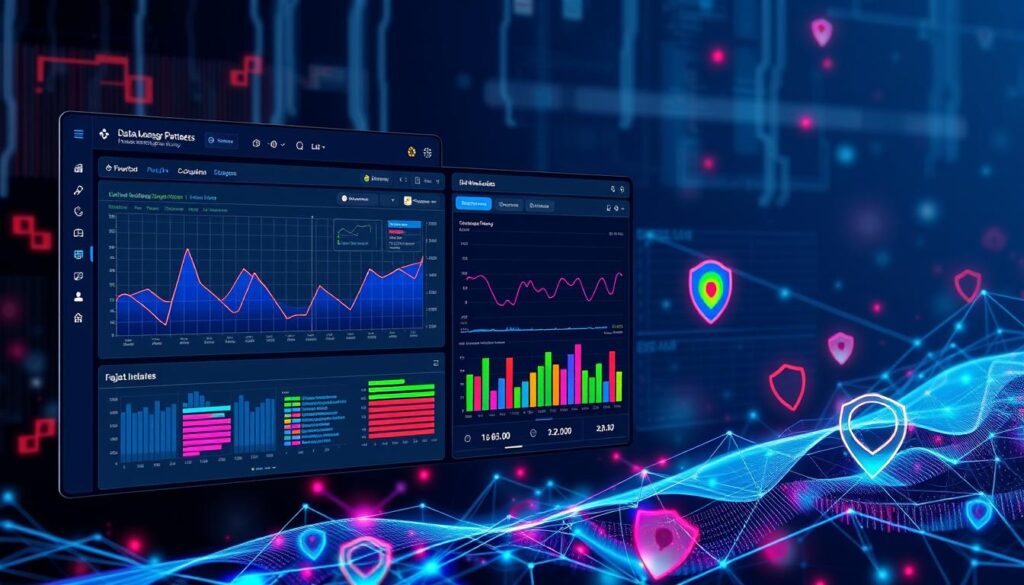FTC disclaimer: This post contains affiliate links and I will be compensated if you make a purchase after clicking on my link.
In today’s world, a good data management platform (DMP) is key for any business. But finding the right one can be tough. Let’s explore the top 10 DMPs that can boost your sales and marketing.
Key Takeaways
- Data management platforms (DMPs) help organizations collect, manage, and analyze data from various sources for targeted marketing campaigns.
- The top 10 best DMPs offer a wide range of features, including data integration, security, scalability, and advanced analytics.
- Selecting the right DMP depends on factors such as integration capabilities, data privacy, cost, and overall usability.
- DMPs are increasingly crucial for modern marketing teams to make sense of the vast amounts of data they deal with daily.
- Understanding the key differences between DMPs and customer data platforms (CDPs) is important when choosing the right data management solution.
What Is a Data Management Platform (DMP)?
A data management platform (DMP) is a set of tools for managing data. It helps organizations gather and analyze data from many sources. This includes ads, sales systems, and websites.
DMPs work well with different databases, data lakes, or warehouses. They take in data, clean it, sort it, and make it one. This helps marketers understand and use their data better.
Understanding DMPs
DMPs help companies know their customers better and target ads more effectively. They use first-, second-, and third-party data to give marketers insights. First-party data comes from websites, CRM systems, and more. Second-party data is from working with other companies. Third-party data is from other websites and social media.
How DMPs Work
DMPs get data from many places, like CRM software and third-party brokers. They analyze this data to understand customers. This lets marketers create better ads and reach the right people.

“Quality data-driven marketing ensures targeted, personalized messages and supports customers along the purchasing process.”
DMPs are key for the digital ad world. They help advertisers, agencies, and publishers make their ads better. This makes marketing more effective.
Benefits of Using a Data Management Platform
Using a data management platform (DMP) helps companies a lot. DMPs give deep insights into what customers like and do. This makes marketing campaigns more effective and profitable.
DMPs collect data from many places like websites and CRM systems. They use this data to make detailed profiles of customers. This way, marketers can send messages that really speak to their audience.
- Improved targeting: DMPs help create specific audience segments based on collected data, enabling more effective targeting of marketing campaigns.
- Data enrichment: DMPs can enrich customer profiles with identifiers like IP addresses, email addresses, and mobile advertising IDs, providing a more comprehensive view of the customer.
- Personalization: By leveraging the insights gathered through a DMP, companies can deliver more personalized experiences, leading to increased customer engagement and conversions.
- Streamlined marketing efforts: DMPs can serve as a centralized resource for planning and executing marketing campaigns, reducing time wasted on data-related tasks.
DMPs also make marketing more efficient and effective. They help save money while making campaigns work better. Using a DMP well means making quick changes to campaigns and creating targeted audiences.
| Benefits of Using a DMP | Impact |
|---|---|
| Improved targeting | Enables more effective targeting of marketing campaigns by creating specific audience segments based on collected data. |
| Data enrichment | Enhances customer profiles with identifiers like IP addresses, email addresses, and mobile advertising IDs, providing a more comprehensive view of the customer. |
| Personalization | Leverages insights gathered through the DMP to deliver more personalized experiences, leading to increased customer engagement and conversions. |
| Streamlined marketing efforts | Serves as a centralized resource for planning and executing marketing campaigns, reducing time wasted on data-related tasks. |
| Improved efficiency and optimization | Contributes to the efficiency and optimization of marketing efforts, potentially reducing marketing spend while increasing campaign effectiveness. |
In conclusion, DMPs offer many benefits for companies. They help in understanding customers better, making marketing more personal, and improving strategies. This leads to better results and more profit.

Key Features to Look for in a DMP
When picking a data management platform (DMP), look at a few key things. First, it should work well with other tools you use, like content management systems (CMSs) and customer relationship management (CRM) tools. This makes sure you have a complete view of your customer data and makes your work easier.
Next, the DMP’s ability to handle lots of data is important. It should be able to manage first-party, second-party, and third-party data well. This helps power your marketing with data.
Data Security and Privacy
Data security and privacy are very important today. Choose a DMP that focuses on keeping your data safe. It should follow rules like the General Data Protection Regulation (GDPR) and the California Consumer Privacy Act (CCPA). The platform should use strong encryption, keep data safe, and control who can see it.
| Features of a Good DMP | Why They Matter |
|---|---|
| Data Integration Capabilities | Enables a holistic view of customer data and streamlined workflows |
| Scalable Data Collection and Processing | Supports the management of large volumes of first-party, second-party, and third-party data |
| Data Security and Privacy Measures | Ensures the protection and compliance of customer data |
By focusing on these important features, you can find a DMP that meets your needs. This lets you use customer insights to make your marketing better.

DMP vs. Customer Data Platform (CDP)
Data management platforms (DMPs) and customer data platforms (CDPs) are similar but different. Knowing these differences helps you pick the best tool for your business.
A DMP focuses on gathering and managing data from many sources. It helps marketers understand their campaigns better. On the other hand, a CDP tracks individual customers. It uses data from different places to build detailed profiles of customers.
| Metric | DMP | CDP |
|---|---|---|
| Data Types Handled | Third-party data (cookies, segmented customer IDs) | First-party, second-party, and third-party data (PII) |
| Data Storage | Short-term (focus on third-party data) | Long-term (build accurate customer profiles) |
| User Profiles | Anonymous behavioral data tied to cookies | Specific data identifying individual customers (email, etc.) |
| Data Selection and Capture | Website visitations, time spent, content viewed | Avoid anonymous data, focus on individual customer identifiers |
| Role in Marketing Strategy | Historical data analysis, digital channel utilization, audience segmentation | Understand customer needs, purchase behavior, enhance social media and offline interactions |
Choosing between a DMP vs. CDP depends on your marketing goals and data use. By understanding the differences, you can pick the best tool for your business.
Top Data Management Platforms in 2023
In 2023, the best data management platforms (DMPs) are leading the way. Adobe Audience Manager and Oracle Bluekai stand out. They offer top-notch data handling, growth, and easy campaign setup across many channels.
Adobe Audience Manager
Adobe Audience Manager is part of the Adobe Experience Cloud. It connects well with Adobe’s ad platforms. This lets marketers use data from both online and offline sources for targeted campaigns.
It helps businesses collect and use data wisely. This way, they can understand their audience better and segment them well.
Oracle Bluekai
Oracle Bluekai comes from the Oracle Data Cloud. It helps companies gather data from many places, online and offline. It has tools like the Oracle ID Graph for a complete customer view.
These top DMPs in 2023 are key for businesses to use their data well. They help make marketing smarter, improve customer groups, and reach the right people.

Google Audience Center
Google Audience Center is part of the Google DMP. It helps users track ad campaigns on Google, YouTube, and more. It lets users see detailed reports using Analytics 360. This makes managing ads easier.
It’s great for making audience segments based on what users do and who they are. This helps marketers reach the right people. They can use these segments in many Google ads, like display ads and YouTube videos.
Google Audience Center also has strong analytics. Users can see how well their ads are doing. They can track things like views, clicks, and how much money they make. This helps marketers improve their ads.
In short, Google Audience Center is a top Google DMP. It works well with Google’s ads. It’s good for making ads better and getting more from digital ads.
Best Data Management Platforms (DMP)
There are many top data management platforms (DMPs) besides Adobe Audience Manager and Oracle Bluekai. These leading software solutions have special features for different business needs.
Lotame DMP is great for finding and reaching new customers. It can make over 60,000 audience segments. This helps users find and target new groups of customers.
Salesforce Audience Studio, once known as Krux, is a full DMP solution. It works well with Salesforce. It helps with collecting, segmenting, and using data for marketing.
Permutive DMP focuses on keeping customer data safe and under control. It helps businesses follow privacy rules with its customer data platform (CDP).
Onaudience.com is easy to use and affordable. It has nearly 12 billion user profiles. It’s good for all kinds of businesses, with a simple interface and many data options.
These top DMPs, along with others, have many features. They help businesses manage and use customer data for better marketing.
Lotame DMP
In the world of digital marketing, Lotame’s data management platform (DMP) is a top choice. It helps businesses use their audience data to its fullest. Lotame’s tools let marketers create campaigns that really speak to their audience.
Lotame’s Strengths: Unlocking the Power of Data
Lotame’s DMP shines in several areas, making it great for marketers and advertisers:
- Extensive Data Connectivity: Lotame’s platform collects data from many sources. This includes web analytics, mobile apps, CRM data, social networks, and TV data.
- Powerful Audience Segmentation: It lets businesses create special audience groups. This is done using first-, second-, and third-party data sources. It helps reach the most valuable customers.
- Advanced Identity Resolution: Lotame connects data across devices and platforms. This gives a full view of audience behavior and preferences.
- Flexible Data Partnerships: Lotame works well with many marketing and advertising platforms. This makes data-driven campaigns more flexible and effective.
Lotame’s DMP helps businesses improve their marketing. They can offer personalized experiences that really connect with their audience. This leads to better results.
“Lotame’s data management platform has been a game-changer for our business. The platform’s ability to collect and enrich data from diverse sources has allowed us to create highly targeted and effective campaigns that have delivered impressive results.” – Marketing Manager, Retail Brand
Salesforce Audience Studio
Salesforce Audience Studio is a data management platform (DMP) in the Salesforce family. It helps businesses mix and sort data from many places. This includes CRM, web analytics, social media, and third-party sources.
It works well with other Salesforce tools like Marketing Cloud and Advertising Studio. This way, companies can send out messages that are just right for their customers on different platforms.
Salesforce Audience Studio is made for big companies that use Salesforce. It puts all customer data in one place. It also uses AI to understand audiences better.
This helps businesses make their customers happier and run better marketing campaigns.
But, the future of Salesforce Audience Studio is not clear. The world is moving away from third-party cookies and old DMPs. The platform might struggle with new privacy rules because it relies on cookies.
So, Salesforce might switch to its customer data platform (CDP), Marketing Cloud CDP. This could be a better way to handle data and talk to customers.
“Salesforce Audience Studio collects, stores, organizes, and centralizes data from different sources for each customer, allowing for a deep understanding of individual behaviors and preferences.”
As things change in the data world, companies using Salesforce Audience Studio should keep an eye on trends. They might need to find new ways to manage data that focus on first-party data and customers.
The platform’s future will depend on how well Salesforce can change with the times. It needs to offer a complete solution that meets its customers’ needs.
Permutive DMP
Data management platforms (DMPs) are key for businesses to understand their audience better. But, with growing privacy concerns, new DMPs focus on protecting data while still performing well. Permutive DMP is one such platform, focusing on privacy and audience targeting.
Permutive DMP uses edge computing to process data on the user’s device. This method cuts down on latency and boosts privacy. It also fits into the trend of moving away from traditional tracking methods.
Permutive DMP is different because it doesn’t rely on third-party data. It lets businesses collect data from web and mobile sources without needing third-party cookies. This is great for marketers who are ready for the end of third-party cookies.
The perks of Permutive DMP go beyond privacy. It uses edge computing for fast data processing and audience segmentation. This means marketers can offer personalized content to their audience. The platform also makes it easy to combine different data sources for a full customer view.
Permutive DMP is a top choice for businesses looking to manage data in a privacy-focused way. It’s ready for the changing digital world, offering a way to get audience insights while keeping customer privacy in mind.
Onaudience.com
In today’s digital world, businesses of all sizes see the value of data-driven marketing. Onaudience.com is a top data management platform (DMP). It helps marketers use data insights without spending a lot.
Onaudience.com gathers and manages data from over 21 billion monthly users across 200 countries and regions. It offers a wide range of data segments. These include demographics, interests, behaviors, intents, and sales history. This helps businesses make targeted and personalized marketing campaigns.
“The key to effective marketing in today’s digital age lies in the ability to understand and connect with your audience. Onaudience.com’s DMP offers a user-friendly and self-service platform that levels the playing field for small and medium-sized businesses, allowing them to harness the power of data-driven insights.”
Onaudience.com’s DMP is known for being cost-effective. It has a simple and easy-to-use platform. This makes it possible for businesses of all sizes to use a DMP without spending too much.
Whether you’re a small startup or a mid-sized enterprise, Onaudience.com’s DMP can help. It offers a lot of data, is easy to use, and is affordable. Onaudience.com is set to change the game in data management platforms.
Factors to Consider When Choosing a DMP
When picking a data management platform (DMP), look at a few key things. Check how well it integrates data, its security and privacy, and how it handles data. Also, see how easy it is to use and its cost to make sure it fits your business needs.
The granularity of data tracking is very important. Being able to track data on many devices is key. Also, being able to mix different data types is important for the DMP to work well.
Another big thing is how well the DMP can analyze customers and predict their purchases. It should handle lots of data and give access to many data sources. Being able to break down audiences into small groups is also a big plus.
“Marketers face challenges with scaling DMP capabilities as more data sources become available globally, necessitating adaptable solutions.”
When looking at a DMP, think about its integration capabilities, how easy it is to use, and its security. Also, consider how well it scales, its performance, and the support it offers. The cost, including setup and ongoing expenses, is also important.
The best DMP should be flexible and work well with many platforms. It should keep improving based on what clients say and market trends. By thinking about these things, you can find a DMP that makes the most of your data and helps your marketing goals.
Implementing a Data Management Platform
Setting up a data management platform (DMP) is key for any organization. It means linking the platform with your data sources and marketing tools. You also need to set up data collection, manage user access, and train your team.
Integration and Setup
The first step is to connect your DMP with your data sources. This includes web analytics, CRM systems, and other data providers. This connection helps your DMP gather and unify all important data, giving you a full view of your customers.
Then, you must set up how the DMP collects and processes data. This means defining data sources, setting up data schedules, and making sure the data is transformed and enriched correctly. Doing this right helps your DMP give you accurate insights.
It’s also important to set up user access and permissions. Decide who in your organization can use the DMP and what they can do. This keeps your data safe and lets the right people make informed decisions.
Lastly, training your team on the DMP is essential. Teach them about the DMP’s features and how to use it for data analysis and audience segmentation. This way, your team can get the most out of the DMP and make the most of your data.
By planning and setting up your data management platform well, you can unlock its full potential. This helps your organization become more data-driven.
Measuring DMP Performance
It’s key to check how well your data management platform (DMP) works. By watching important numbers, you learn a lot. This helps you make smart choices to improve your data use.
Look at data quality and completeness first. Check if your data is right, up-to-date, and full. Good data helps you target your audience better.
Also, see how well your DMP groups your audience. This means checking if it correctly sorts people by what they like and who they are. This helps you send messages that really speak to your customers.
Don’t forget to watch how your DMP helps your marketing campaigns. Look at things like how many people click on your ads and how much money you make. This shows if your DMP is working well.
Lastly, think about the DMP ROI. This means looking at how much money your DMP has made for your business. Knowing this helps you see if it’s worth it and where you can get better.
| Metric | Importance | Benchmark |
|---|---|---|
| Data Quality and Completeness | Ensures the accuracy and reliability of your DMP data | Aim for a data quality score of at least 90% |
| Audience Segmentation Accuracy | Enables effective targeting and personalization | Target a segmentation accuracy of 85% or higher |
| Campaign Optimization Results | Measures the performance of your DMP-powered marketing initiatives | Strive for a campaign ROI of at least 20% |
| DMP ROI | Quantifies the financial impact of your DMP investment | Aim for a DMP ROI of at least 3:1 |
By checking these important numbers often, you make sure your data management platform is worth it. This smart way of using data helps your DMP work better. And that means better results for your business.
Conclusion
Data management platforms are key for today’s marketing teams. They help manage data from many sources. This way, teams can understand their customers better and make their marketing more effective.
Platforms like Adobe Audience Manager and Salesforce Audience Studio offer special features. They help marketers meet their needs. This makes marketing more personal and successful.
Choosing the right DMP is important. Look at data integration, security, and cost. The right platform can make your marketing better. It’s all about finding the best fit for your business.
Data management platforms are vital in today’s digital world. They help with personalization and targeting. By using them, businesses can offer great experiences to their customers.








